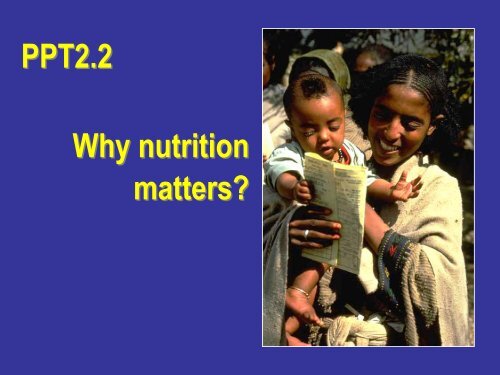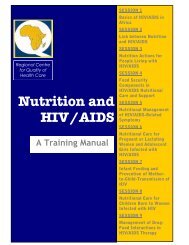Why nutrition matters, Ethiopia - Linkages Project
Why nutrition matters, Ethiopia - Linkages Project
Why nutrition matters, Ethiopia - Linkages Project
You also want an ePaper? Increase the reach of your titles
YUMPU automatically turns print PDFs into web optimized ePapers that Google loves.
PPT2.2<br />
<strong>Why</strong> <strong>nutrition</strong><br />
<strong>matters</strong>?
Presentation 2.2…<br />
Overview of mal<strong>nutrition</strong> today…<br />
• What progress has been made?<br />
• View of mal<strong>nutrition</strong>.<br />
• <strong>Why</strong> <strong>nutrition</strong> <strong>matters</strong>?<br />
The ways forward…<br />
• Macroeconomic policies<br />
• Sectoral policies<br />
• Direct <strong>nutrition</strong> programs Essential Nutrition Actions
Declaration of the<br />
1974 World Food Summit<br />
‘… all governments and the international<br />
community as a whole …. eliminate within a<br />
decade hunger and mal<strong>nutrition</strong>’<br />
(Resolution V)
Mal<strong>nutrition</strong> today – what progress<br />
have we achieved today,<br />
nearly 30 years later?
Mal<strong>nutrition</strong> today – what progress<br />
have we achieved today,<br />
nearly 30 years later?<br />
Some global trends<br />
in mal<strong>nutrition</strong>…
Focus on levels of stunting (low ht/age)<br />
Child stunting level good indicator of socio-economic<br />
conditions<br />
• mal<strong>nutrition</strong> can ‘cost’ a young child up to 11 cm of height by the age of<br />
two years<br />
Much better reflection of human development than<br />
economic indicators
Trends in stunting<br />
(low height for age) in children < 5 yrs,<br />
by region and year<br />
75<br />
% stunted<br />
50<br />
25<br />
0<br />
1980 1990 1995 2000<br />
4 th Report on World Nutrition Situation, ACC/SCN<br />
SS Africa Asia South America
Rates of stunting in children < 5 years have<br />
increased or remained high in Africa<br />
60<br />
%<br />
40<br />
20<br />
0<br />
1980 1990 2000<br />
East and Southern West North<br />
De Onis et al, 2000 - WHO Global Databank
The number of stunted children is rising<br />
dramatically in Africa<br />
Number of children in millions<br />
60<br />
40<br />
20<br />
0<br />
1980 1990 2000<br />
East and Southern West North Total<br />
De Onis et al, 2000 - WHO Global Databank
Prevalence of stunting in children under<br />
five years, in selected east African<br />
countries<br />
100<br />
75<br />
Percentage<br />
50<br />
51<br />
43<br />
38<br />
33<br />
25<br />
0<br />
<strong>Ethiopia</strong> Tanzania Uganda Kenya
Some problems with dealing with mal<strong>nutrition</strong>:<br />
In the past there was a lack of<br />
consensus on the:<br />
• nature of the mal<strong>nutrition</strong> problem<br />
• causes of the problem…<br />
• what actions to take…
Two extreme schools of thought…<br />
Technologists:<br />
•technological interventions (eg.<br />
magic bullets) can solve the<br />
problem<br />
Structuralists:<br />
•eradicating poverty will solve the<br />
problem
Past problems dealing with mal<strong>nutrition</strong>:<br />
Too many viewpoints led to<br />
CONFUSION<br />
and<br />
a lack of agreement on<br />
how to tackle mal<strong>nutrition</strong>…
Today a much greater consensus exists…<br />
a mix of both<br />
technologist and structuralist<br />
elements
Conceptual Framework of Mal<strong>nutrition</strong><br />
Nutritional Status<br />
Manifestations<br />
Diet<br />
Health<br />
Immediate<br />
Causes<br />
Household<br />
Food Security<br />
Care of Mother<br />
and Child<br />
Environ. Health,<br />
Hygiene & Sanitation<br />
Underlying<br />
Causes<br />
Human, Economic, and<br />
Institutional Resources<br />
Political and Ideological Structure<br />
Ecological Conditions<br />
Root<br />
Causes<br />
Adapted from UNICEF<br />
Potential Resources
Conceptual Framework of Mal<strong>nutrition</strong><br />
Nutritional Status<br />
Manifestations<br />
Diet<br />
Health<br />
Immediate<br />
Causes<br />
Household<br />
Food Security<br />
Care of Mother<br />
and Child<br />
Environ. Health,<br />
Hygiene & Sanitation<br />
Underlying<br />
Causes<br />
Human, Economic, and<br />
Institutional Resources<br />
Political and Ideological Structure<br />
Ecological Conditions<br />
Root<br />
Causes<br />
Adapted from UNICEF<br />
Potential Resources
Conceptual Framework of Mal<strong>nutrition</strong><br />
Nutritional Status<br />
Manifestations<br />
Diet<br />
Health<br />
Immediate<br />
Causes<br />
Household<br />
Food Security<br />
Care of Mother<br />
and Child<br />
Environ. Health,<br />
Hygiene & Sanitation<br />
Underlying<br />
Causes<br />
Human, Economic, and<br />
Institutional Resources<br />
Political and Ideological Structure<br />
Ecological Conditions<br />
Root<br />
Causes<br />
Adapted from UNICEF<br />
Potential Resources
Conceptual Framework of Mal<strong>nutrition</strong><br />
Nutritional Status<br />
Manifestations<br />
Diet<br />
Health<br />
Immediate<br />
Causes<br />
Household<br />
Food Security<br />
Care of Mother<br />
and Child<br />
Environ. Health,<br />
Hygiene & Sanitation<br />
Underlying<br />
Causes<br />
Human, Economic, and<br />
Institutional Resources<br />
Political and Ideological Structure<br />
Ecological Conditions<br />
Root<br />
Causes<br />
Adapted from UNICEF<br />
Potential Resources
Some myth-information on <strong>nutrition</strong>…<br />
• Increasing food production will reduce mal<strong>nutrition</strong><br />
• Protein deficiency is the cause of mal<strong>nutrition</strong><br />
• Children in developing countries are genetically short<br />
• Mal<strong>nutrition</strong> should be left in the hands of <strong>nutrition</strong>ists
<strong>Why</strong> <strong>nutrition</strong> <strong>matters</strong>?<br />
Human and<br />
Economic Costs
Ethical Imperative<br />
Nutrition is<br />
a human right…
Negative functional consequences<br />
Illness & Mortality<br />
Intelligence loss<br />
Reduced productivity
Consequences of Mal<strong>nutrition</strong><br />
Current scientific data<br />
Profiles<br />
Computer model<br />
Functional Consequences
Quantifying the human & economic losses<br />
• Some assumptions:<br />
• Period: over six years<br />
• UN Medium Population <strong>Project</strong>ions<br />
• E-DHS 2000, National Surveys & MOH Reports
Mal<strong>nutrition</strong><br />
&<br />
Child Survival
Major causes of death<br />
among children under five, world, 2000<br />
Other<br />
29%<br />
Pneumonia<br />
20%<br />
Deaths<br />
associated with<br />
under<strong>nutrition</strong><br />
60%<br />
Diarrhoea<br />
12%<br />
Malaria<br />
8%<br />
Perinatal<br />
Measles<br />
HIV/AIDS<br />
22%<br />
5%<br />
4%<br />
EIP/WHO; Caulfield et al, forthcoming<br />
5
Child Mortality<br />
(six year period)<br />
UNICEF/C-56-19/Murray-Lee<br />
1,030,000 child deaths due to PEM<br />
(470 deaths every day)
Underweight and Mortality<br />
… the majority of these deaths, as<br />
much as 80%, are associated with<br />
mild and moderate mal<strong>nutrition</strong><br />
… invisible to ‘see’ as nearly all<br />
<strong>Ethiopia</strong>n children are<br />
malnourished
Breastfeeding Practices<br />
In <strong>Ethiopia</strong>,<br />
70%<br />
of infants are<br />
sub-optimally<br />
breastfed<br />
UNICEF/93-COU-0173/Lemoyne
Deaths of <strong>Ethiopia</strong>n infants due to suboptimal<br />
breastfeeding practices<br />
(six year period)<br />
412,000 infants deaths linked to PEM
Vitamin A Deficiency<br />
• Night blindness<br />
• Ulceration of the cornea<br />
• Permanent blindness
Vitamin A Deficiency and Mortality<br />
Improving vitamin A status can<br />
reduce child mortality by 23-34%
VAD: Associated Mortality<br />
(over six year period)<br />
298,000 deaths of <strong>Ethiopia</strong>n children<br />
UNICEF/ Pirozzi
Human Losses<br />
(over six year period)<br />
Over 1,000,000<br />
child lives lost due<br />
to protein-energy<br />
mal<strong>nutrition</strong> and<br />
vitamin A<br />
deficiency<br />
UNICEF/HQ91-0031/Eritrea/Sprague
Mal<strong>nutrition</strong><br />
&<br />
Education
Mal<strong>nutrition</strong> and Education<br />
Reduced:<br />
• Intellectual development<br />
• School performance<br />
• Economic productivity
Mal<strong>nutrition</strong> and Education<br />
Iron deficiency anemia lowers IQ by about 9 points<br />
Mild iodine deficiencies lowers IQ by about 10 points<br />
Severe stunting associated with IQ loss of 5-10 points<br />
Low birth weight babies have IQs 5 points lower
Iodine Deficiency in <strong>Ethiopia</strong><br />
Total Goiter Rate = 22%<br />
(over six year period)<br />
124,000 Severe mental retardation<br />
416,000 Moderate mental retardation<br />
3,620,000 Mild intellectual disability<br />
4,160,000 All grades of mental disability<br />
UNICEF/<strong>Ethiopia</strong>
Mal<strong>nutrition</strong><br />
&<br />
Economic Development
Productivity losses in <strong>Ethiopia</strong> due<br />
to iodine deficiency<br />
(over six year period)<br />
Present value = US $936 million
Stunting & Productivity<br />
Inadequate nutrients in<br />
quantity and quality in<br />
first two years of life
Stunting & Productivity<br />
Height deficit as much as<br />
11cm by 24 months of<br />
age<br />
…stunted children<br />
become stunted adults
Stunting & productivity<br />
1.4% decrease in productivity for every<br />
1% decrease in height<br />
(Haddad & Bouis, 1990)
Stunting (0-24 Months)<br />
(EDHS - 2000)<br />
55%<br />
stunted
Economic losses due to stunting<br />
(over six year period)<br />
• Present value = US $2,031 million
Total economic losses<br />
(over six year period)<br />
3000<br />
US $2,967 million<br />
Economic Losses (US$ million)<br />
0<br />
2,031<br />
936<br />
Stunting<br />
Iodine Deficiency
In summary, the functional consequences<br />
of mal<strong>nutrition</strong> are immense<br />
Deficiency<br />
Reduces
In summary, the functional consequences<br />
of mal<strong>nutrition</strong> are immense:<br />
Deficiency<br />
Vitamin A<br />
Reduces<br />
survival
In summary, the functional consequences<br />
of mal<strong>nutrition</strong> are immense:<br />
Deficiency<br />
Vitamin A<br />
PEM<br />
Reduces<br />
survival<br />
productivity
In summary, the functional consequences<br />
of mal<strong>nutrition</strong> are immense:<br />
Deficiency<br />
Vitamin A<br />
PEM<br />
Iron<br />
Reduces<br />
survival<br />
productivity<br />
intelligence
In summary, the functional consequences<br />
of mal<strong>nutrition</strong> are immense:<br />
Deficiency<br />
Vitamin A<br />
PEM<br />
Iron<br />
Iodine<br />
Reduces<br />
survival<br />
productivity<br />
intelligence
Impact is significant<br />
Human costs<br />
Economic costs
Improved <strong>nutrition</strong> is an essential input<br />
into human & national development<br />
Key word is<br />
“input”<br />
Can’t afford to wait for improved <strong>nutrition</strong> to be an<br />
output of overall ‘trickle-down’ development
Planners from each sector need to address:<br />
impact of <strong>nutrition</strong> on their sector<br />
impact of their sector on <strong>nutrition</strong>
In <strong>Ethiopia</strong><br />
Where can we focus our efforts?
Conceptual Framework of Mal<strong>nutrition</strong><br />
Nutritional Status<br />
Manifestations<br />
Diet<br />
Health<br />
Immediate<br />
Causes<br />
Household<br />
Food Security<br />
Care of Mother<br />
and Child<br />
Environ. Health,<br />
Hygiene & Sanitation<br />
Underlying<br />
Causes<br />
Human, Economic, and<br />
Institutional Resources<br />
Political and Ideological Structure<br />
Ecological Conditions<br />
Root<br />
Causes<br />
Adapted from UNICEF<br />
Potential Resources
1. Macroeconomic Policies<br />
2. Sectoral Policies<br />
3. Direct Nutrition Interventions
Macroeconomic Policies<br />
… Trade and exchange rate policies<br />
… Price policy (real income)<br />
… Allocation of public expenditure<br />
… Social safety nets (subsidies, public works &, feeding<br />
programs, targeting…)
Sectoral Policies<br />
… agriculture: availability, access, and stability<br />
… health (especially primary)<br />
… education (especially primary)<br />
… environment<br />
… commerce<br />
… etc
Special focus on roles &<br />
situation of women as:<br />
…farmers<br />
…wage earners<br />
…child caretakers<br />
…home providers
Key issues related to women and <strong>nutrition</strong>al outcomes<br />
Nutritional Status<br />
Diet<br />
Health<br />
Household<br />
Food Security<br />
Care of Mother<br />
and Child<br />
Environ. Health,<br />
Hygiene & Sanitation<br />
Women’s<br />
control of:<br />
•Income<br />
•Decisions<br />
•Physical<br />
capital<br />
•Food<br />
resources<br />
Women’s<br />
access to:<br />
•Land<br />
•Credit<br />
•Technology<br />
•Information<br />
•Physical capital<br />
•Employment<br />
Women’s time<br />
constraints:<br />
•Farm work<br />
•Off-farm work<br />
•Family care<br />
•Child care<br />
Women’s<br />
knowledge:<br />
•Self esteem<br />
•Education<br />
•Beliefs<br />
Women’s health<br />
and <strong>nutrition</strong>al<br />
status:<br />
•Labor<br />
productivity<br />
•Fertility<br />
•Child<br />
caretaking<br />
•Maternal-infant<br />
mal<strong>nutrition</strong><br />
cycle
Direct Nutrition Interventions<br />
… maternal and child health programs<br />
… supplementary feeding programs<br />
… fortification<br />
… etc
Direct <strong>nutrition</strong> interventions,<br />
… when should we intervene?<br />
Majority of growth<br />
faltering occurs during<br />
first year of life
When should we intervene?<br />
Many babies are<br />
born malnourished<br />
due to poor maternal<br />
<strong>nutrition</strong> before &<br />
during pregnancy
Where should we intervene?<br />
Focus on:<br />
• infant & young child feeding,<br />
especially 0-24 months<br />
• <strong>nutrition</strong> of girls & women
One way to move forward is<br />
The Essential<br />
Nutrition Actions:<br />
An Action Oriented<br />
Approach<br />
for all Sectors
One way to move forward is<br />
The Essential<br />
Nutrition Actions:<br />
An Action Oriented<br />
Approach<br />
for all Sectors
Thank you<br />
Prepared by Victoria Quinn (AED/LINKAGES) based on materials from:<br />
Agnes Guyon, AED/LINKAGES<br />
<strong>Ethiopia</strong> Profiles Team and AED/FANta, 2000
















